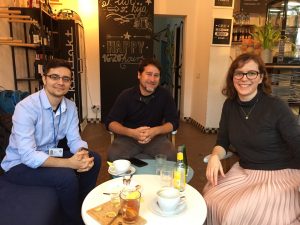Robert Ellliott regularly teaches the LT 608 CALL (Computer-Assisted Language Learning) course in the LTS Program. Next term (Winter 2018) he will also be teaching LT 535 (Language Teaching Methods) and creating an online version of this course to be offered in Summer 2018. In addition to LTS, Robert works at University of Oregon’s Northwest Indian Languages Institute (NILI), through which he takes some very interesting trips…
Dzien dobry
Dzien dobry, (good day/morning/afternoon/evening), a standard greeting in Polish. In November, Robert traveled to Warsaw, Poland. We asked him a few questions to find out what he was doing there.
Why Warsaw?
Janne Underriner, NILI Director, and I were invited to a small conference and workshop on Endangered Languages that was hosted by the Engaged Humanities project at the School of Liberal Arts, University of Warsaw. I had recently met Justyna Olko, the faculty member in charge of this project, at another conference in Barcelona, Spain earlier in the spring. She was very interested in the work of NILI and the endangered language context of the United States and Pacific Northwest. She is the administrator of a European Union grant that is working on community-university partnerships in language revitalization, something they call Participatory Action Research (PAR). PAR is a relatively new idea in the European endangered language
landscape, and Justyna was impressed by the fact that NILI has been doing similar type of work for some 20 years. So we had a paper accepted for the conference and she invited us to come and speak for a half day at the pre-conference workshop.
Who attended this conference?
Largely there were two groups: those working on endangered languages in Europe, and those working on endangered languages in Mesoamerica. The Europeanists were working on languages like Franco-Provençial, Basque or some of the Polish minority languages like Wymysorys. A young 20-something man named Tymoteusz Król was exposed to the Wymysorys language by his grandmother and has become a leader in the revitalization of this language. The Meso-Americanists were working on languages of Mexico and Central America, such as Nahuatl, K’iche’, Mixe, Mixtec, Mayo, and Nahuat-Pipil. There was so much to learn, both by similarities and by contrasts, to other endangered language situations. Also attending were some notable names in the field, including Leonora Grenoble (University of Chicago), Peter Austin and Julia Sallabank (SOAS University of London), and Colette Grinevald (University of Lyon 2).

Robert (right) socializes with Michel, Janne, Benedict, Marion and Colette after finishing their presentations.
What did you talk about?
For the workshop, we talked about three things: the context of language revitalization in the Pacific Northwest, Language as a Protective Factor for Native Youth, and a Case Study of a Youth PAR Project over time. For the conference we took a close look at PAR in action as it developed for a class Janne taught that was developed in partnership with tribal groups and the UO. We also had meetings about collaborations on a book with Justyna and our Polish colleagues, and we met with our French colleagues from Lyon, (Colette, Michel Bert, and Benedict Pivot) to map out some research we are doing.
Who else did you meet with while there?

Robert (center) meets with Krystyna Luto (right), faculty of the Warsaw Medical University, along with one of the department’s Fulbright English teachers to discuss collaborations with the UO.
While in Warsaw I met with Krystyn Luto, faculty member of the Warsaw Medical University. She gave me a tour of the building she works in, the new library, and some of the classrooms and offices of her department. Afterwards, we went to a crepe cafe near her office, and discussed some possible collaborations between the English classes she is in charge of and UO’s American English Institute. The most interesting thing about the medical school is that students can take classes in either Polish or English. Many international students come to Warsaw Medical University to get their degree, and typically they, along with some Polish students who are interested in working internationally, may choose to take their courses in English. Students are usually studying to become M.D.s, nurses, or laboratory technicians, and are typically quite serious about their studies and focused on their need for language.
What did you think of Warsaw?
Well first off, I had heard Poland is a beer country and indeed I was not disappointed. I had little to no expectations about the city of Warsaw before going. I had lived in Sweden in the 1990s, and people would travel to Poland for shopping because it was cheap. But my stereotype of a poor, former eastern block country was shattered by this trip. The city was amazing, with tremendous architecture of both “old looking” (Warsaw was completely devastated during WWII and all the “old” buildings are actually reconstructions built post war) and the utmost modern skyscrapers standing side by side, and fantastic murals. There are numerous parks around the city to explore, and the Vistula River runs right near the center and old town. Fantastic museums: The ones I saw included the POLIN Museum of History of Polish Jews, the Resistance Museum, the Neon Museum, and the Chopin Museum. The transportation system – one ticket gets you subways, trolle
ys and buses – was quick and easy to navigate. The beer was fantastic! And the food was out of this world delicious! The Polish cuisine is very unique, a mixture of northern farm grown produce, bountiful aged meats and cheeses, fresh fish from the Baltic and delicate pastries and desserts, gourmet chocolates, all prepared with extraordinary detail to flavor and presentation. And it was cheap! I never once ate a polish sausage. Oh, and did I mention the beer?
Would you go back?
Yes, for sure, but preferably in the spring or summer.





